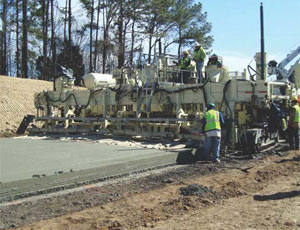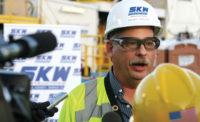As the result of a rare closure of interstate highway, a 15-mi rehabilitation of Interstate 385 near Laurens, S.C., is on track to be completed in just eight months—and for two-thirds of its original estimated cost.

Originally constructed as U.S. Route 276, the four-lane divided highway linking Greenville with Interstate 26 was added to the interstate system in the mid-1980s even though it hadn’t been designed to those standards. While aspects such as narrow shoulders didn’t hinder traffic safety, they did complicate the South Carolina Dept. of Transportation’s plans to replace the highway’s deteriorating 1950s-era pavement.
SCDOT program manager Rob Perry says the typical staged construction strategy often involves diverting all traffic onto one side of the highway for short stretches while the other side is reconstructed.
“As is, we would have had a very narrow corridor for two-way traffic, plus problems for emergency access in the event of a crash,” Perry adds. “Rebuilding the shoulders first was an option, but it would have added a year to the construction schedule.”
At the suggestion of the Federal Highway Administration, SCDOT elected to close the northbound side of I-385 entirely for construction. Detouring traffic onto adjacent roads would be a temporary inconvenience for motorists but allow rehabilitation work to proceed virtually unobstructed. The southbound lanes could then be rehabilitated using the staged approach, with traffic temporarily routed onto the completed—and wider—northbound side.
With petroleum prices at or near record levels in the summer of 2009 and the overall construction market slowing down, SCDOT also found that the cost of using concrete for the new surface compared favorably with asphalt.
“Along with being cost-competitive, concrete would help us get the project done faster because the contractor could put in the entire (pavement) at once under the right conditions,” Perry says, unlike asphalt pavement, which is usually placed in stages, or “lifts.”
Competition for the project also produced a good price. “The winning bid of $27 per sq yd was nearly half of the design estimate,” says Bill Dubose, executive director of the Concrete Pavement Association of South Carolina.
The shutdown of northbound I-385 began at midnight on Jan. 4. After milling the existing asphalt to correct cross-slopes, lead contractor McCarthy Improvement Co. of Laurens began applying the 30-ft-wide, 10-in-thick overlay for the mainline traffic lanes and inside shoulder using a laser-guided Guntert & Zimmerman slipform paver with compact dowel inserters.
McCarthy project manager Nick Wolf says that despite several bouts of unusually cold, wet weather, mainline construction on the northbound side was completed in approximately two months. A roller-compacted concrete surface is being installed for the outside shoulder.
“RCC is a more unusual type of concrete to work with, but the project has gone smoothly overall,” Wolf says. “We’ve already started doing some work on the southbound lanes.”
And even with moderated petroleum costs, Perry says the project’s bottom line is still looking good. The rehabilitation, which includes replacement of a 310-ft-long, two-lane flyover bridge at the I-26 interchange, is expected to cost approximately $61 million and be finished in early August.
“That’s a savings of approximately $34.6 million over the three-year staged construction approach,” and the expected design life of the concrete pavement is more than 50 years, Wolf says.





Post a comment to this article
Report Abusive Comment